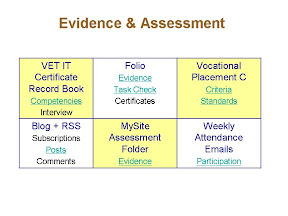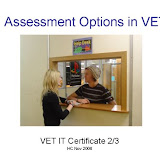Engaged Learners
Many new curriculum talk about "engaging learners". For example, our new state curriculum framework for years 11/12 is about
"enaging with all students in the learning that will empower them to create and realise purposeful futures."I've been reading
some blog posts questioning what it means to be an 'engaged learner', what's new about 'engaging learners' and how you might assess 'engagement'. Some good provocative questions - and they got me thinking...
While I can point out engaged learners in most classes at my school it is clear that not every student is engaged - some are disenaged and some (many?) are passive learners. But before jumping too quickly into how I 'know' this I thought I should start to map what makes an engaged learner. Then perhaps I can talk about whether it can be measured...
From my own experience and reading things
like this and
this I've mapped out the following (still needs work):

The blue boxes represent engaged learning processes while the green boxes show some common curriculum goals/intended outcomes. (If you use CMaps and want to edit it you can find it in Public spaces (2) --> Curriculum 2006 (userid:hent password:blog)
No wonder enagement is hard to pin down - let alone assess. On the other hand most teachers can tell when a student is really engaged in their learning... mostly through observation and conversation - you can often see it in their body language and hear it in their voice.
I think I'll let this sit a while before thinking about if and/or how one might measure the degree of enagement...
Labels: engagement, learning
Assessing in VET - Freedom, Structure and Personalisation
One of the classes I teach is a year 11/12 vocational education class in Information Technology - a combined Certificate 2/3 class. The course is actually a double class of 9hrs per week and is assessed against both the
AQF VET Certificate
competencies and the
TQA Vocational Learning criteria. I recently gave a presentation showing how this course is structured and assessed.
The slides are linked below but they need some explanation...
(names and faces have been blurred for privacy)
The course has been designed to meet a number of needs:
- the wide diversity of student IT knowledge/skills/understanding
- the lack of some specific IT knowledge/skills by the teacher(s)
- the requirement for students to experience a real IT workplace
- the efficient management of assessment as learning, for learning and of learning
The wide range of student expertise provides both challenges and opportunities. Each student needs a personalised learning program based on what they already know and what they need to know. Each student knows something the others do not and can therefore help to teach. The course is highly structured to provide individual student freedom across multiple learning opportunities/environments. (See slides above for more detail.)
Students progress at their own pace through a list of class tasks; they form expert groups to research and present information; they work in a Helpdesk Office servicing 1100 students and staff; they maintain one of the ten campus computer labs (lab watch); they may opt to work in an outside business/industry; they maintain hardware in the Helpdesk Workshop; they complete online courses; they attend and run formal Helpdesk meetings; they work on projects on site, in the workplace or at home.
Some online courses are mandated and others are chosen by students. We use online courses provided by SkillSoft (purchased), Microsoft Training (free) and other internet sites.
This year I was involved in team-teaching the course with Jon - in previous years I have taught the double-class myself. How do I manage and assess all of this? Over the last few years I have evolved the following management and assessment strategies.
 | Evidence of student competency is collected by the students and collated using a number of ICT tools. |
| From vet_assessment |
Each student collects evidence of their learning in a digital (MySite) or paper-based folio (most did both). This includes certificates from online courses, photo's from the workplace, project report forms, client evaluation sheets, class tasks... Students either write a blog or write in their paper-based folio (most chose a blog) about new technology (they subscribe to RSS feeds) and reflection on their learning. Each week every student replies to an email detailing participation across the nine learning environments.
I sit down with each student as and when required and sign off specific VET IT competencies in their formal Record Book and validate their self assessment against the Vocational Learning criteria. It all works quite well :-)
PS I'm playing with google - personalisation, widgets, picasa... and upgrading my blog - that's why you may have got the whole blog as a 'new post' in your RSS feed...
Labels: assessment, folio, freedom, personalisation, structure







